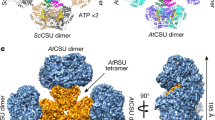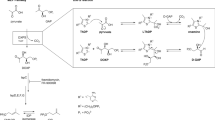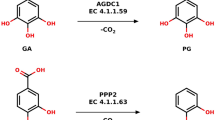Abstract
Dehydroquinate synthase (DHQS) has long been regarded as a catalytic marvel because of its ability to perform several consecutive chemical reactions in one active site1,2,3,4,5,6,7. There has been considerable debate as to whether DHQS is actively involved in all these steps1,2, or whether several steps occur spontaneously, making DHQS a spectator in its own mechanism3,4,5. DHQS performs the second step in the shikimate pathway, which is required for the synthesis of aromatic compounds in bacteria, microbial eukaryotes and plants8. This enzyme is a potential target for new antifungal and antibacterial drugs9,10 as the shikimate pathway is absent from mammals and DHQS is required for pathogen virulence11. Here we report the crystal structure of DHQS, which has several unexpected features, including a previously unobserved mode for NAD+-binding and an active-site organization that is surprisingly similar to that of alcohol dehydrogenase, in a new protein fold. The structure reveals interactions between the active site and a substrate-analogue inhibitor, which indicate how DHQS can perform multistep catalysis without the formation of unwanted by-products.
This is a preview of subscription content, access via your institution
Access options
Subscribe to this journal
Receive 51 print issues and online access
$199.00 per year
only $3.90 per issue
Buy this article
- Purchase on Springer Link
- Instant access to full article PDF
Prices may be subject to local taxes which are calculated during checkout



Similar content being viewed by others
References
Srinivasan, P. R., Rothchild, J. & Sprinson, D. B. The enzymatic conversion of 3-deoxy-d- arabino -heptulosinic acid 7-phosphate to 5-dehydroquinate. J. Biol. Chem. 238, 3176–3182 (1963).
Bartlett, P. A., McLaren, K. L. & Marx, M. A. Divergence between the enzyme-catalysed and noncatalysed synthesis of 3-dehydroquinate. J. Org. Chem. 59, 2082–2085 (1994).
Widlanski, T. S., Bender, S. L. & Knowles, J. R. Dehydroquinate synthase: A sheep in wolf's clothing? J.Am. Chem. Soc. 111, 2299–2300 (1989).
Bender, S. L., Widlanski, T. & Knowles, J. R. Dehydroquinate synthase: The use of substrate analogues to probe the early steps of the catalysed reaction. Biochemistry 28, 7560–7572 (1989).
Bartlett, P. A. & Satake, K. Does dehydroquinate synthase synthesize dehydroquinate? J. Am. Chem. Soc. 110, 1628–1630 (1988).
Lambert, J. M., Boocock, M. R. & Coggins, J. R. The 3-dehydroquinate synthase activity of the pentafunctional arom enzyme complex of Neurospora crassa is Zn2+ dependent. Biochem. J. 226, 817–829 (1985).
Montchamp, J.-L. & Frost, J. W. Cyclohexenyl and cyclohexylidene inhibitors of 3-dehydroquinate synthase: Active site interactions relevant to enzyme mechanisms and inhibitor design. J. Am. Chem. Soc. 119, 7645–7653 (1997).
Bentley, R. The shikimate pathway — a metabolic tree with many branches. Crit. Rev. Biochem. Mol. Biol. 25, 307–384 (1990).
Kishore, G. M. & Shah, D. M. Amino acid biosynthesis inhibitors as herbicides. Annu. Rev. Biochem. 57, 27–63 (1988).
Pittard, A. J. Biosynthesis of aromatic amino acids. Escherichia coli and Salmonella typhimurium: Cellular and Molecular Biology(eds Niedhardt, F. C. et al.) 1, 368–394 (Am. Soc. Microbiol., Washington, DC, (1987)).
Günel-Özcan, A., Brown, K. A., Allen, A. & Maskell, D. J. Salmonella typhimurium aroB mutants are attenuated in BALB/c mice. Microbial Pathogen. 17, 169–174 (1997).
Case, M. E. & Giles, N. H. Partial enzyme aggregates formed by pleiotropic mutants in the arom gene cluster of Neurospora crassa. Proc. Natl. Acad. Sci. USA 68, 58–62 (1971).
Hawkins, A. R., Lamb, H. K., Moore, J. D., Charles, I. G. & Roberts, C. F. The prechorismate (shikimate) and quinate pathways in filamentous fungi: theoretical and practical aspects. J. Gen. Microbiol. 139, 2891–2899 (1993).
Rossmann, M. G., Moras, D. & Olsen, K. W. Chemical and biological evolution of a nucleotide-binding protein. Nature 250, 194–199 (1974).
Lesk, A. M. NAD-binding domains of dehydrogenases. Curr. Opin. Struct. Biol. 5, 775–783 (1995).
Kleywegt, G. J. & Jones, T. A. Where freedom is given, liberties are taken. Structure 3, 535–540 (1995).
Holm, L. & Sander, C. Protein structure comparison by alignment of distance matrices. J. Mol. Biol. 233, 123–138 (1993).
Murzin, A. G., Brenner, S. E., Hubbard, T. & Chothia, C. SCOP-A structural classification of proteins database for the investigation of sequences and structures. J. Mol. Biol. 247, 536–540 (1995).
Eklund, H. et al. Three-dimensional structure of horse liver alcohol dehydrogenase at 2.4 Å resolution. J. Mol. Biol. 102, 27–59 (1976).
Eklund, H. et al. Structure of the triclinic ternary complex of horse liver alcohol dehydrogenase at 2.9 Å resolution. J. Mol. Biol. 146, 561–587 (1981).
Van Den Hombergh, J. P. T. W., Moore, J. D., Charles, I. G. & Hawkins, A. R. Overproduction in Escherichia coli of the dehydroquinate synthase domain of the Aspergillus nidulans pentafunctional AROM protein. Biochem. J. 284, 861–867 (1992).
Moore, J. D., Coggins, J. R., Virden, R. & Hawkins, A. R. Efficient independent activity of a monomeric, monofunctional dehydroquinate synthase derived from the N-terminus of the pentafunctional AROM protein of Aspergillus nidulans. Biochem. J. 301, 297–304 (1994).
Otwinowski, Z. & Minor, W. Processing of X-ray diffraction data collected in oscillation mode. Meth. Enzymol. 276, 307–326 (1996).
The CCP4 suite: programs for protein crystallography. Acta Crystallogr. D 50, 760–763 (1994).
Terwilliger, T. C., Kim, S.-H. & Eisenberg, D. Generalised method of determining heavy atom positions using the difference Patterson function. Acta Crystallogr. A 43, 1–5 (1987).
Jones, T. A., Zou, J.-Y., Cowan, S. W. & Kjeldgaard, M. Improved methods for building protein models in electron-density and the location of errors in these models. Acta Crystallogr. A 47, 110–119 (1991).
Tronrud, D. E., The TNT Refinement Package Manual, 1–191, Oregon State Board of Higher Education((1993)).
Brunger, A. T. Free R -value — a novel statistical quantity for assessing the accuracy of crystal structures. Nature 355, 472–475 (1992).
Esnouf, R. M. An extensively modified version of Molscript that includes greatly enhanced coloring capabilities. J. Mol. Graph. Model. 15, 132 (1997).
Acknowledgements
We thank the support staff at the Synchrotron Radiation Source at Daresbury Laboratory, UK, for assistance; D. R. Swatman, F.T.F. Tsai, R. R. Patel and Y. S. Li for technical assistance; G. G. Dodson for support and encouragement; K. Henrick, S. Gamblin, M. Hirschberg, J. O. Baum, W.Taylor and J. D. Moore for discussion; and P. Bartlett for helpful comments. This work was supported by BBSRC. E.P.C. was supported by the UK MRC and K.A.B. received a BBSRC Advanced Fellowship.
Author information
Authors and Affiliations
Corresponding author
Rights and permissions
About this article
Cite this article
Carpenter, E., Hawkins, A., Frost, J. et al. Structure of dehydroquinate synthase reveals an active site capable of multistep catalysis. Nature 394, 299–302 (1998). https://doi.org/10.1038/28431
Received:
Accepted:
Issue Date:
DOI: https://doi.org/10.1038/28431
This article is cited by
-
Revisiting the shikimate pathway and highlighting their enzyme inhibitors
Phytochemistry Reviews (2023)
-
Natural allelic variation confers high resistance to sweet potato weevils in sweet potato
Nature Plants (2022)
-
Architecture and functional dynamics of the pentafunctional AROM complex
Nature Chemical Biology (2020)
-
Cyanobacterial antimetabolite 7-deoxy-sedoheptulose blocks the shikimate pathway to inhibit the growth of prototrophic organisms
Nature Communications (2019)
-
IMB-T130 targets 3-dehydroquinate synthase and inhibits Mycobacterium tuberculosis
Scientific Reports (2018)
Comments
By submitting a comment you agree to abide by our Terms and Community Guidelines. If you find something abusive or that does not comply with our terms or guidelines please flag it as inappropriate.



